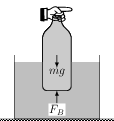Archimedes Principle
A common statement of Archimedes principle is: ``When a body is immersed in a liquid, the buoyant force on the body is equal to the weight of liquid displaced by it''.
Procedure
Fill a 1-litre plastic bottle with water and screw on its cap. Hold the bottle by the cap. You will feel some strain in your fingers because you have to apply an upward force to hold the bottle at rest.

Now dip the bottle in a bucket of water, putting about half the bottle inside water. The strain on your fingers will now be less. This means that you are applying a lesser upward force to hold the bottle at rest. This is because the water exerts an upward force on the bottle. This reduces your burden.
Gradually immerse more of the bottle inside the water. As you do so, the strain on your fingers reduces further. This means that the upward force exerted by the water increases as more of the bottle gets into the water. So, when the bottle is completely immersed in water, you have to apply a very small force to hold the bottle.
Take a thick, long rubber band and cut it so that you have two free ends. Tie a stone at one end, and tie the other end to a fix support. The rubber band will get stretched. Because of this it will pull the stone upwards. This pull balances the weight of the stone.
Now, what do you think will happen if you immerse the hanging stone in water? To check whether your answer is correct, put a jug of water below the stone so that the stone gets immersed in water. You will find that the rubber band is now stretched by a smaller amount. Why?
Because the water exerts an upward force on the stone. So, the upward force needed to balance the weight of the stone reduces. Hence, the band has to exert a smaller upward force. Therefore, it is stretched by a smaller amount.
Related
Subscribe to our channel
